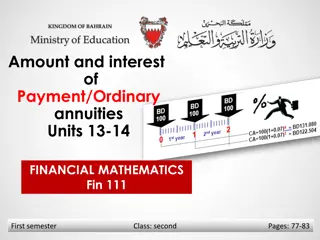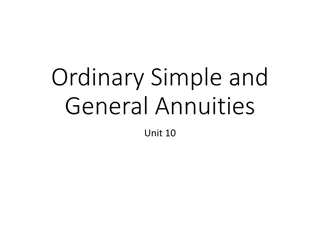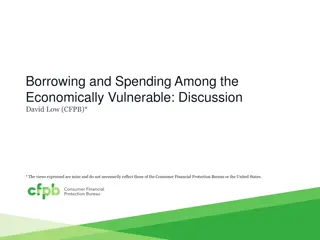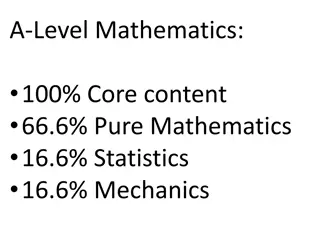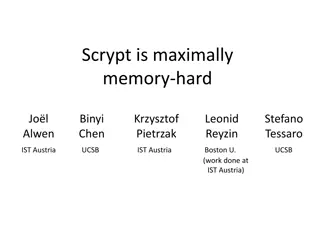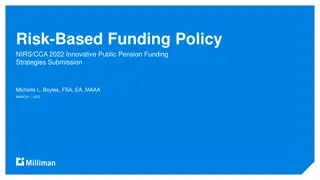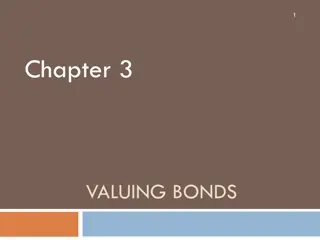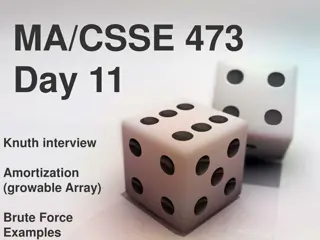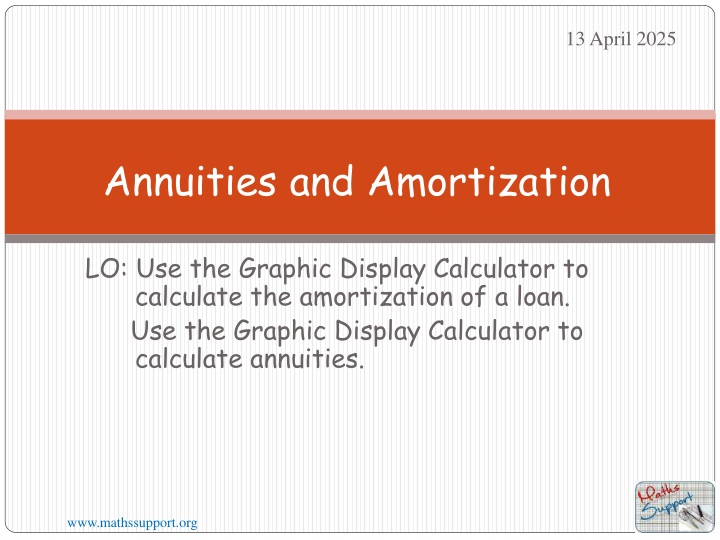
Loan Amortization and Annuities: Understanding Payments and Balances
Explore the concept of loan amortization and annuities, learning how periodic payments are calculated and distributed towards interest and principal. An example calculation with monthly payments is illustrated to help grasp these financial processes.
Download Presentation

Please find below an Image/Link to download the presentation.
The content on the website is provided AS IS for your information and personal use only. It may not be sold, licensed, or shared on other websites without obtaining consent from the author. If you encounter any issues during the download, it is possible that the publisher has removed the file from their server.
You are allowed to download the files provided on this website for personal or commercial use, subject to the condition that they are used lawfully. All files are the property of their respective owners.
The content on the website is provided AS IS for your information and personal use only. It may not be sold, licensed, or shared on other websites without obtaining consent from the author.
E N D
Presentation Transcript
13 April 2025 Annuities and Amortization LO: Use the Graphic Display Calculator to calculate the amortization of a loan. Use the Graphic Display Calculator to calculate annuities. www.mathssupport.org
Amortization Amortization is a repayment of a loan in equal periodic payments. The payments are made at fixed time intervals. The periodic payments are of equal size. The payments are made at the end of the compounding period. The payment is large enough to cover periodic interest and reduce some of the balance. The future value FV of the payments must equal the future value of investing the principal PV in an account with the same interest rate and compounding. www.mathssupport.org
Amortization The future value FV of the payments (annuities) must equal the future value of investing the principal in a compound interest account with the same interest rate and compounding. ?? 1 +? ?? ?? = ? 1 +? ? 1 ? ? ? ? ? = ?? 1 +? ? 1 ? ? ? ?? ? 1 +? = ? Here, big P is the Present value of the loan, little p is the payment that amortized big P. www.mathssupport.org
Amortization Example 1: Kevin take out a $1000 loan. The terms of the 1-year loan are 5% annual interest compounded monthly on the unpaid balance. How much are the monthly payments? Using the formula 1 +? ? ? ? ?? P= r= 1000 5% = 0.05 12 1 ? ? 1 ?? ? 1 +? = ? n= t= p= Substituting 12 1 0.05 12) ) ( 1 (1 + p 12 1 0.05 12)= (1 + 100 0.05 12 p= 85.60748179 Solving for p The monthly payments are $85.61 www.mathssupport.org
Amortization Each payment is broken down into two parts: the interest owed is paid first and then the rest of the payment goes towards paying off the amount owed (principal). The amount of interest paid is the largest in your first payment, while nearly all of the last payment goes towards the principal. Even though the payment is the same each month, the distribution of interest and principal changes with every payment www.mathssupport.org
Amortization Complete the amortization table for the example 1 Kevin take out a $1000 loan. The terms of the 1-year loan are 5% annual interest compounded monthly on the unpaid balance. Interest paid Interest Principal paid Remaining Balance Payment Principal Month 1000.00 0 1 85.61 4.17 4.17 81.44 81.44 918.56 2 85.61 3.83 7.99 81.78 163.22 836.78 3 85.61 3.49 11.48 82.12 245.34 754.66 4 85.61 3.14 14.62 82.46 327.80 672.20 5 85.61 2.80 17.43 82.81 410.61 589.39 6 85.61 2.46 19.88 83.15 493.76 506.24 7 85.61 2.11 21.99 83.50 577.26 422.74 8 85.61 1.76 23.75 83.85 661.11 338.89 9 85.61 1.41 25.16 84.20 745.30 254.70 10 85.61 1.06 26.23 84.55 829.85 170.15 11 85.61 0.71 26.93 84.90 914.75 85.25 12 85.61 0.36 27.29 85.25 1000.00 0 www.mathssupport.org
Amortization Example 2: The Federal Perkins Loan is a low-interest loan for both undergraduate and graduate students. The interest rate for a Perkins loan is 5% compounded monthly with monthly payments and the borrower has up to 10 years to repay. Suppose a student has a $19,000 Perkins Loan and will take 10 years to repay it. (a) What is the total amount of payments over the life of the loan? (b) What are the monthly payments? (c) What is the balance after 4 years? (d) How much interest is paid over the life of the loan? www.mathssupport.org
Amortization Example 2: The Federal Perkins Loan is a low-interest loan for both undergraduate and graduate students. The interest rate for a Perkins loan is 5% compounded monthly with monthly payments and the borrower has up to 10 years to repay. Suppose a student has a $19,000 Perkins Loan and will take 10 years to repay it. (a) What is the total amount of payments over the life of the loan? 120 payments In 10 years with monthly payments 10 12 = 120 www.mathssupport.org
Amortization Example 2: The Federal Perkins Loan is a low-interest loan for both undergraduate and graduate students. The interest rate for a Perkins loan is 5% compounded monthly with monthly payments and the borrower has up to 10 years to repay. Suppose a student has a $19,000 Perkins Loan and will take 10 years to repay it. (b) What are the monthly payments? We will use a GDC to solve this question CASIO www.mathssupport.org
Amortization Example 2: The Federal Perkins Loan is a low-interest loan for both undergraduate and graduate students. The interest rate for a Perkins loan is 5% compounded monthly with monthly payments and the borrower has up to 10 years to repay. Suppose a student has a $19,000 Perkins Loan and will take 10 years to repay it. (b) What are the monthly payments? Using the GDC F2 Compound interest www.mathssupport.org
Amortization Example 2: The Federal Perkins Loan is a low-interest loan for both undergraduate and graduate students. The interest rate for a Perkins loan is 5% compounded monthly with monthly payments and the borrower has up to 10 years to repay. Suppose a student has a $19,000 Perkins Loan and will take 10 years to repay it. (b) What are the monthly payments? Using the GDC F2 n= I%= 5 -19 000 Compound interest 10 12 = 120 PV= PMT= FV= P/Y= We want to know 0 12 12 C/Y= www.mathssupport.org
Amortization Example 2: The Federal Perkins Loan is a low-interest loan for both undergraduate and graduate students. The interest rate for a Perkins loan is 5% compounded monthly with monthly payments and the borrower has up to 10 years to repay. Suppose a student has a $19,000 Perkins Loan and will take 10 years to repay it. (b) What are the monthly payments? Using the GDC F2 n= I%= 5 -19 000 Compound interest 10 12 = 120 PV= PMT= FV= P/Y= We want to know 0 12 12 F4 PMT C/Y= www.mathssupport.org
Amortization Example 2: The Federal Perkins Loan is a low-interest loan for both undergraduate and graduate students. The interest rate for a Perkins loan is 5% compounded monthly with monthly payments and the borrower has up to 10 years to repay. Suppose a student has a $19,000 Perkins Loan and will take 10 years to repay it. (b) What are the monthly payments? Using the GDC F2 n= I%= 5 -19 000 Compound interest 10 12 = 120 PV= PMT= FV= P/Y= 201.52 0 12 12 F4 PMT C/Y= www.mathssupport.org
Amortization Example 2: The Federal Perkins Loan is a low-interest loan for both undergraduate and graduate students. The interest rate for a Perkins loan is 5% compounded monthly with monthly payments and the borrower has up to 10 years to repay. Suppose a student has a $19,000 Perkins Loan and will take 10 years to repay it. (a) What is the total amount of payments over the life of the loan? 120 payments (b) What are the monthly payments? (c) What is the balance after 4 years? $201.52 (d) How much interest is paid over the life of the loan? www.mathssupport.org
Amortization Example 2: The Federal Perkins Loan is a low-interest loan for both undergraduate and graduate students. The interest rate for a Perkins loan is 5% compounded monthly with monthly payments and the borrower has up to 10 years to repay. Suppose a student has a $19,000 Perkins Loan and will take 10 years to repay it. (c) What is the balance after 4 years? AMORTZN Using the GDC F6 EXIT www.mathssupport.org
Amortization Example 2: The Federal Perkins Loan is a low-interest loan for both undergraduate and graduate students. The interest rate for a Perkins loan is 5% compounded monthly with monthly payments and the borrower has up to 10 years to repay. Suppose a student has a $19,000 Perkins Loan and will take 10 years to repay it. (c) What is the balance after 4 years? AMORTZN Using the GDC F6 EXIT PM1= PM2 = 4 12 = 48 10 12 = 120 1 n= I%= PV= PMT= -201.524479 5 19 000 F1 BAL 12 C/Y= 12 P/Y= www.mathssupport.org
Amortization Example 2: The Federal Perkins Loan is a low-interest loan for both undergraduate and graduate students. The interest rate for a Perkins loan is 5% compounded monthly with monthly payments and the borrower has up to 10 years to repay. Suppose a student has a $19,000 Perkins Loan and will take 10 years to repay it. (c) What is the balance after 4 years? AMORTZN Using the GDC F6 EXIT PM1= PM2 = 4 12 = 48 10 12 = 120 1 n= I%= PV= PMT= -201.524479 5 19 000 F1 BAL 12 P/Y= C/Y= 12 www.mathssupport.org
Amortization Example 2: The Federal Perkins Loan is a low-interest loan for both undergraduate and graduate students. The interest rate for a Perkins loan is 5% compounded monthly with monthly payments and the borrower has up to 10 years to repay. Suppose a student has a $19,000 Perkins Loan and will take 10 years to repay it. (a) What is the total amount of payments over the life of the loan? 120 payments (b) What are the monthly payments? (c) What is the balance after 4 years? $201.52 $12 513.21 (d) How much interest is paid over the life of the loan? www.mathssupport.org
Amortization Example 2: The Federal Perkins Loan is a low-interest loan for both undergraduate and graduate students. The interest rate for a Perkins loan is 5% compounded monthly with monthly payments and the borrower has up to 10 years to repay. Suppose a student has a $19,000 Perkins Loan and will take 10 years to repay it. (d) How much interest is paid over the life of the loan? Using the GDC PM2 = 120 EXIT INT F4 www.mathssupport.org
Amortization Example 2: The Federal Perkins Loan is a low-interest loan for both undergraduate and graduate students. The interest rate for a Perkins loan is 5% compounded monthly with monthly payments and the borrower has up to 10 years to repay. Suppose a student has a $19,000 Perkins Loan and will take 10 years to repay it. (d) How much interest is paid over the life of the loan? Using the GDC PM2 = 120 EXIT INT 5 182.94 F4 www.mathssupport.org
Amortization Example 2: The Federal Perkins Loan is a low-interest loan for both undergraduate and graduate students. The interest rate for a Perkins loan is 5% compounded monthly with monthly payments and the borrower has up to 10 years to repay. Suppose a student has a $19,000 Perkins Loan and will take 10 years to repay it. (a) What is the total amount of payments over the life of the loan? 120 payments (b) What are the monthly payments? (c) What is the balance after 4 years? $201.52 $12 513.21 (d) How much interest is paid over the life of the loan? $5 182.94 www.mathssupport.org
13 April 2025 Annuities using technology LO: Use the Graphic Display Calculator to calculate annuities. www.mathssupport.org
Annuities An annuity is a savings account in which money is deposited at regular intervals, rather than one large lump-sum The payments are made at fixed time intervals. The periodic payments are of equal size. The payments are made at the end of the interval. The interest is paid at the end of the interval. www.mathssupport.org
Annuities The formula for annuities is . ?? 1 +? ? 1 ? ? ? ? = Where: p= regular deposit amount, r= rate n= compounding frequency t= years A= future value The most common compounding frequencies are: Compounding Times per year Annually Semi-annualy 1 Quarterly 4 Monthly 12 Weekly 52 Daily 365 2 www.mathssupport.org
Annuities Example 1: Ryan deposits $100 every month into an annuity at 5% compounded monthly, for 9 years. Find the future value and the interest his account earned. ?? 1 +? ? 1 Using the formula ? ? ? ? = p= r= 100 5% = 0.05 12 9 ? 12 9 0.05 12) n= t= A= Using the calculator the Future value is ) ( 1 (1 + 100 A= Substituting 0.05 12 A= 13 604.32 www.mathssupport.org
Annuities Example 1: Ryan deposits $100 every month into an annuity at 5% compounded monthly, for 9 years. Find the future value and the interest his account earned. What is the interest earned? She made $100 deposits every month for 9 years. That is 108 deposits of $100 each, so she personally deposited $10,800. Interest = I= I= p= r= 100 5% = 0.05 12 9 13 604.32 n= t= A= Future value - Total deposited - 10 800 13 604.32 2 804.32 www.mathssupport.org
Using a GDC Example 1: Ryan deposits $100 every month into an annuity at 5% compounded monthly, for 9 years. Find the future value and the interest his account earned. Now we are going to use Graphing display calculator to solve the problem CASIO www.mathssupport.org
Annuities Example 1: Ryan deposits $100 every month into an annuity at 5% compounded monthly, for 9 years. Find the future value and the interest his account earned. Turn on the GDC MENU TVMor Financial www.mathssupport.org
Annuities Example 1: Ryan deposits $100 every month into an annuity at 5% compounded monthly, for 9 years. Find the future value and the interest his account earned. Turn on the GDC MENU TVMor Financial F2 Compound interest www.mathssupport.org
Annuities Example 1: Ryan deposits $100 every month into an annuity at 5% compounded monthly, for 9 years. Find the future value and the interest his account earned. Turn on the GDC MENU TVM or Financial F2 Compound interest Number of payment periods The percentage rate, given as a percent. The present value of the account. If money is being paid into the account, PV is entered as a negative number; PMT= FV= P/Y= C/Y= 12 12 9 = 108 5 0 n= I%= PV= -100 The amount of each payment. Future value of the account. Number of payments per year. Number of compoundings per year. We want to know 12 www.mathssupport.org
Annuities Example 1: Ryan deposits $100 every month into an annuity at 5% compounded monthly, for 9 years. Find the future value and the interest his account earned. Turn on the GDC MENU TVM or Financial F2 Compound interest n= I%= 5 0 12 9 = 108 PV= -100 PMT= FV= P/Y= C/Y= We want to know 12 F5 FV 12 www.mathssupport.org
Annuities Example 1: Ryan deposits $100 every month into an annuity at 5% compounded monthly, for 9 years. Find the future value and the interest his account earned. Turn on the GDC MENU TVM or Financial F2 Compound interest n= I%= 5 0 12 9 = 108 PV= -100 PMT= FV= P/Y= C/Y= I= We want to know 12 = 13604.32 F5 FV 12 - 10 800 = 2 804.32 13 604.32 www.mathssupport.org
Annuities Example 2: Dave wants to save $20,000 for a down payment on a really cool speedboat. He opens an annuity at 4.25% compounded quarterly for 3 years. What is his quarterly payment? Using the GDC to solve the problem. n= I%= 4.25 0 4 3 = 12 Number of payment periods The percentage rate, given as a percent. The present value of the account. The amount of each payment. Future value of the account. Number of payments per year. Number of compoundings per year. 4 PV= PMT= FV= P/Y= C/Y= We want to know 20 000 4 www.mathssupport.org
Annuities Example 2: Dave wants to save $20,000 for a down payment on a really cool speedboat. He opens an annuity at 4.25% compounded quarterly for 3 years. What is his quarterly payment? Using the GDC to solve the problem. n= I%= 4.25 0 4 3 = 12 PV= PMT= FV= P/Y= C/Y= We want to know 20 000 4 4 F4 PMT www.mathssupport.org
Annuities Example 2: Dave wants to save $20,000 for a down payment on a really cool speedboat. He opens an annuity at 4.25% compounded quarterly for 3 years. What is his quarterly payment? Using the GDC to solve the problem. n= I%= 4.25 0 -1571.50 4 3 = 12 PV= PMT= FV= P/Y= C/Y= 20 000 4 4 F4 PMT www.mathssupport.org
Annuities Example 2: Dave wants to save $20,000 for a down payment on a really cool speedboat. He opens an annuity at 4.25% compounded quarterly for 3 years. What is his quarterly payment? Using the GDC to solve the problem. n= I%= 4.25 0 -1571.50 4 3 = 12 PV= PMT= FV= P/Y= C/Y= He should deposit $1571.50 every three months that combined with the interest, will grow to $20,000 in 3 years. 20 000 4 4 F4 PMT www.mathssupport.org
Thank you for using resources from A close up of a cage Description automatically generated For more resources visit our website https://www.mathssupport.org If you have a special request, drop us an email info@mathssupport.org Get 20% off in your next purchase from our website, just use this code when checkout: MSUPPORT_20 www.mathssupport.org

